Established 1869 Year built 1869 | Area 1.6 km (0.99 mi) Architect William S. Gladstone Founder John Healy | |
Etymology Nickname adopted as official name Similar Indian Battle Park, Nikka Yuko Japanese Garden, Helen Schuler Nature C, Galt Museum & Archives, Henderson Park | ||
Fort whoop up
Fort Whoop-Up was the nickname (eventually adopted as the official name) given to a whisky trading post, originally Fort Hamilton, near what is now Lethbridge, Alberta. During the late 19th century, the post served as a centre for various illegal activities. The sale of whisky was outlawed but, due to the lack of a police force in the region at the time, many whisky traders had settled in the area and taken to charging unusually high prices for their goods.
Contents
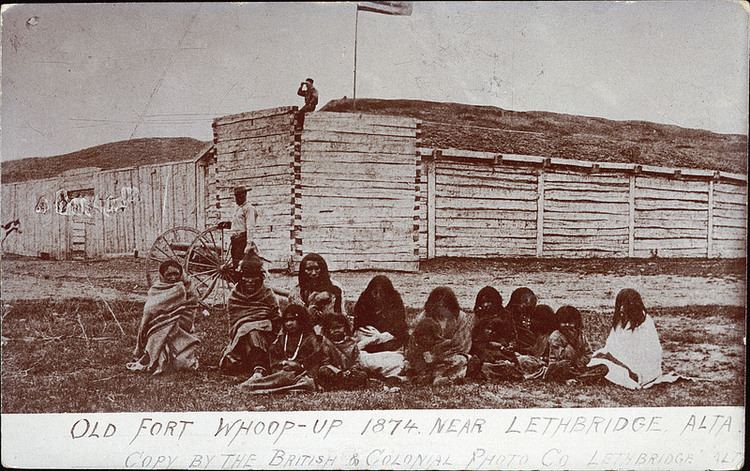
Fort Whoop-Up is also the name of a replica site and interpretive centre built in Indian Battle Park.
History
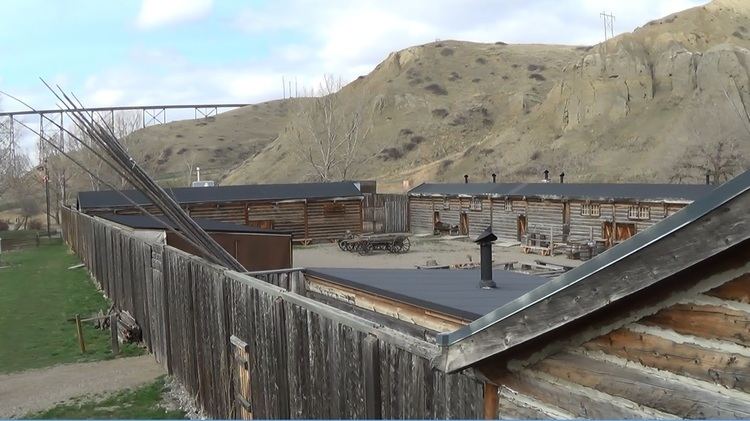
Fort Hamilton was first built in 1869 by J.J. Healy and A.B. Hamilton—two traders from the Fort Benton area of Montana—to serve as a trading post. Its first structure was destroyed by fire within a year of its construction; whether this was an accident or deliberate arson is unknown. A second, more sturdy structure later replaced the first Fort Hamilton, and was later nicknamed Fort Whoop-Up. It took two years to build at a cost of $25,000. It was located at the junction of the Belly (Oldman) River and the St. Mary's River, 6 km (3.7 mi) south of where the Fort Whoop-Up interpretive centre is located.
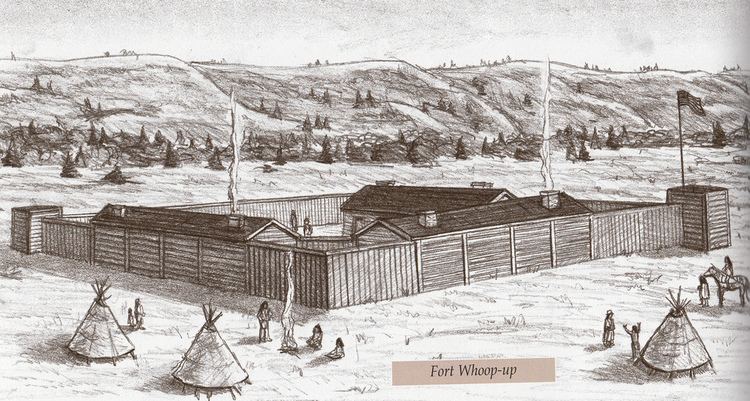
One type of alcohol sold by the Whoop-Up bandits was known as Whoop-Up Bug Juice, a highly prized alcohol spiked with ginger, molasses, and red pepper. It was then coloured with black chewing tobacco, watered down, and boiled to make "firewater".
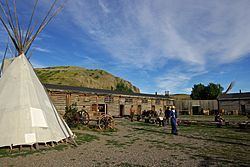
It is commonly thought that the only purpose for Fort Whoop-Up was to trade whisky. Although it was one of the most infamous of the whisky trading posts, there was much more legal trading that occurred here (e.g. trading of furs for blankets, food, firearms) than there was trading of whisky.
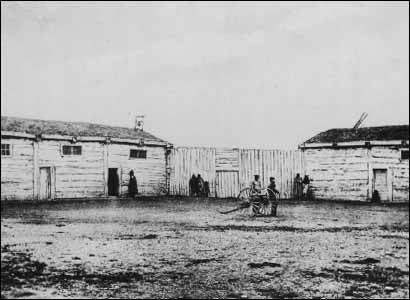
The outlaws of Fort Whoop-Up and surrounding areas—combined with the supposed flying of an American flag over Canadian territory—contributed to the formation of the North-West Mounted Police. Fort Whoop-Up was a destination on their march west in 1874.

The NWMP arrived at Fort Whoop-Up in October 1874, with the task of establishing Canadian sovereignty in the territory and controlling the alcohol trade. They found no whisky on the premises and the flag that had been reported as an American flag was inspected and found to be a trade flag for the fort (later adopted by the City of Lethbridge as the municipal flag). Finding no reason to close the fort, they continued further west and the fort continued in the trade of legal goods.
Their first strike on the alcohol traders came after a Native complained at Fort Macleod about a group of whisky traders who had sold him overpriced whisky. Shortly after, the North-West Mounted Police caught and fined the perpetrators, although they were not at Fort Whoop-Up at the time. Although the presence of the NWMP decreased the abundance of whisky trading, it still occurred.
In 1875, the NWMP rented a room from the owners of the fort, Healy and Hamilton, and established a post there. This arrangement lasted for at least twelve years, the fort acting as both a trading post and a NWMP post. The following year, Healy and Hamilton sold the fort to Dave Akers, who was in control of the fort almost until its demise. The fort was again burned in 1888, the fire having started in the NWMP barracks. This fire was not as severe as only the NWMP barracks were destroyed. The fort remained in operation until it was deserted somewhere between 1890 and 1892. It was then destroyed piece by piece until the last of it was washed away in a flood in 1915.
On 28 June 1985 Canada Post issued 'Fort Whoop Up, Alta.' one of the 20 stamps in the “Forts Across Canada Series” (1983 & 1985). The stamps are perforated 12½ x 13 and were printed by Ashton-Potter Limited based on the designs by Rolf P. Harder.
Name
There are several theories as to why the fort was nicknamed Whoop-Up. The most prominent is that it came by a description of the illicit activities that were taking place at the fort; that people said they were going to Fort Hamilton to whoop it up. Another theory comes from the process of getting a bull train moving over the trail. The bull whacker would walk alongside the bull train and crack his whip. This process was called whooping them up, which may have led to the naming of the trail to be Whoop-up Trail, and hence the fort as well.
"Bug juice" and other names
A lot of folklore has grown up around the concept of the various forms of liquor traded in the west with the First Nations peoples. The recipes of those liquors exist mainly in the realm of folk tales, and still require some research and interpretation to bring rationality to the Whoop-Up story. But the naming of those specious and spirituous concoctions has a little more scholarship.
Reconstruction
A reconstruction effort was undertaken to adapt the fort to what it was originally, based on new photographic evidence. The replica site was built as a centennial project, downstream from the original site, in 1967. Since then, various new exhibits have been unveiled, including the Thunderchief Collection, showcasing artifacts from the local Blackfoot culture; the Shockley Firearms Gallery; and Voice from the Past, an audio program that enables visitors and school children to receive guided tours year round. Seasonal re-enactments take place in the summer involving characters from the fort's history, and are done in partnership with Drama Nutz Productions and Guns of the Golden West, as well as local re-enactment talent.
